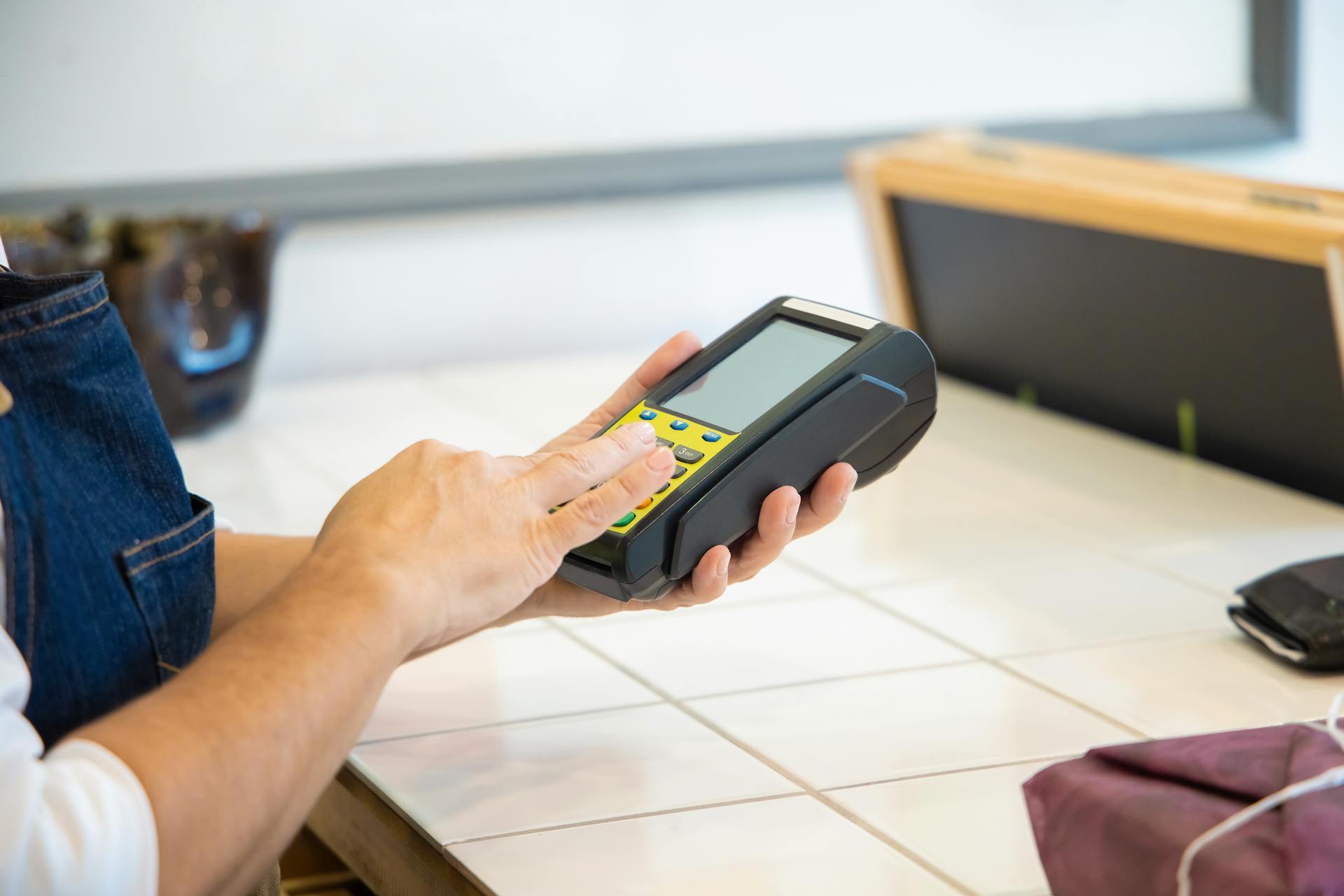
The concept of credit cards has been around for centuries, but the modern credit card as we know it today has a more recent history. The first credit card was introduced in the United States in 1950 by Frank McNamara, Ralph Schneider, and Matty Simmons.
The first credit card, called the Diners Club card, was initially used for gas stations, restaurants, and other merchants who accepted it. It wasn't until 1958 that the first bank-issued credit card, the BankAmericard, was introduced by Bank of America.
The BankAmericard, later renamed Visa in 1976, was the first credit card to be widely accepted by merchants across the United States. It was also the first to introduce the concept of a revolving credit limit, allowing users to pay their balances in full or make minimum payments each month.
Suggestion: United Bank Business Credit Card
The History of Credit Cards
Credit cards have a fascinating history that spans centuries. The concept of credit dates back to the 1700s, where farmers would receive seeds from merchants by promising to pay them back after harvesting their crops.
The first "credit cards" were actually coins made from metal or celluloid, introduced in 1865. These coins listed the issuing retailer's information and an account number.
In the late 19th and early 20th centuries, Western Union provided select customers with metal plates that allowed them to charge now and pay later. By the 1930s, many retailers issued their own form of metal money, commonly known as Charga-Plates.
Here's a brief timeline of major milestones in credit card history:
- 1865: Charge Coins - The first "credit cards" were coins made from metal or celluloid.
- 1914: Metal Money - Western Union introduced one of the first metal charge plates.
- 1934: Air Travel Card - The Air Transport Association and American Airlines introduced the Air Travel Card.
- 1946: Charg-It Card - A Brooklyn-based banker created the first bank card.
- 1950: First Modern Credit Card - Diners Club rolled out its card, the first modern credit card.
- 1969: Magnetic Stripes - The magnetic stripe was first attached to a credit card.
- 1984: First Credit Card Rewards Programs - Diners Club created the first rewards program, Club Rewards.
- 1994: EMV Chips - Europay, Mastercard, and Visa partnered to develop EMV chip technology.
- 1995: First Contactless Payment - The first contactless payment card was introduced in Korea.
- 2008: Mobile Wallet - Mobile wallets began with the Apple app store.
These innovations paved the way for the credit cards we use today.
The Diners Club and Early Players
The Diners Club card, invented in 1950, is known as the first modern-day credit card. It was the brainchild of Frank McNamara, a businessman who forgot his wallet while out to dinner in New York.
In 1950, the Diners Club card was first used only in local restaurants before expanding to include additional retailers. Customers had to pay the balance in full at the end of every month, with no option for minimum payments.
Worth a look: Club Credit Cards
By 1951, the Diners Club boasted 42,000 members and had expanded to major U.S. cities. This rapid growth laid the groundwork for the credit card industry's expansion.
Cardholders could use the Diners Club card at hundreds of restaurants, hotels, and car rental agencies, paying their bills in full at a later date each month. Users paid $5 annually for the service, and merchants paid a 7% fee on charges.
The Diners Club card was the first general-use charge card, and its success paved the way for other credit cards like American Express, which entered the scene in the mid-1950s.
Recommended read: What Credit Score Does Chase Use for Credit Cards
The Invention and Development
The concept of credit dates back thousands of years to ancient Mesopotamia, where inscriptions on clay tablets show transactions between merchants from different regions.
The idea of credit evolved over time, with merchants in the Old West issuing metal coins or small plates as a receipt of a loan to farmers and ranchers who didn't have money to buy supplies.
The first modern credit card was invented in 1950 by Frank McNamara, who created the Diners Club Card, the world's first general-purpose charge card.
Store credit tokens and charge plates existed before McNamara's innovation, dating back to the early 1900s, and department stores had been offering their own credit systems to customers long before him.
The BankAmericard, launched by Bank of America in 1958, was the first consumer credit card to offer revolving credit, and it became Visa in 1976.
For another approach, see: Charge Card vs Credit Cards
Early 1900s: A Spark
In the early 1900s, store-specific charge cards were issued by retailers to their most trusted customers, kind of like ancient credit cards. These cards were paper or metal tokens, and you could only use them at that specific store.
The idea of "buy now, pay later" was already brewing, and these early charge cards were technically credit cards, but they didn't resemble what we use today. They were more like the first ever credit card prototypes, a stepping stone on the path to widespread credit adoption.
Take a look at this: How to Use Credit Cards

Only those with impeccable reputations and a dash of wealth could get one of these early charge cards, which made them exclusive and sought after.
Here's a brief timeline of the early charge cards:
- Early 1900s: Store-specific charge cards were issued by retailers to their most trusted customers.
- 1946: The Charg-It card was introduced by John Biggins, a Brooklyn banker, to bring new customers into the bank.
- 1953: Diners Club introduced the first internationally accepted charge card.
These early charge cards paved the way for the development of modern credit cards, which would eventually become a staple of consumer finance.
The Invention of Credit Cards
The concept of credit can be traced back thousands of years to ancient Mesopotamia, where inscriptions on clay tablets show transactions between merchants.
Store credit tokens and charge plates existed in the early 1900s, issued by retailers to their most trusted customers. These cards were made of paper or metal and could only be used at specific stores.
The idea of "buy now, pay later" was already brewing in the early 1900s, with store-specific charge cards being issued to customers. These cards were not made of plastic, but rather paper or metal tokens.
You might like: How Do Charge Cards Affect Credit Score
Frank McNamara is often credited with inventing the first modern credit card in 1950, by creating the Diners Club Card. However, store credit tokens and charge plates existed before this, dating back to the early 1900s.
John Biggins, a Brooklyn banker, came up with the idea of the Charg-It card in 1946, which allowed people with an account at the bank to use their card at select merchants. The merchant would then send the receipts to the bank, and the bank would pay for the items purchased.
American Express launched its first charge card in 1958, allowing travelers more flexibility. The first transaction was processed using handwritten forms that the merchant needed to mail to the company.
On a similar theme: Bank of America Credit Card Score
1960s: The Magnetic Stripe Era
In the 1960s, the magnetic stripe era revolutionized credit card usage. This decade brought the first magnetic stripe credit card, a game-changer for transactions.
IBM engineer Forrest Parry is credited with affixing magnetic tape to the back of cards, allowing consumers to have their information "swiped" at a point-of-sale terminal. The magnetic tape was originally used to store audio information.
The magnetic stripe made transactions faster and more convenient, with cards now accepted by more than just a few restaurants or gas stations. People could swipe their way through various stores.
The innovation of the magnetic stripe was massive for credit card usage, making it possible for people to pay later and not just with the money in the bank right then.
Industry Regulations
The credit card industry has a rich history of regulation, which has helped shape the way we use credit cards today.
In the early days, discriminatory practices were not uncommon, with many companies refusing to provide credit cards to African Americans and women needing a male co-signer to get a card.
The Fair Credit Reporting Act was introduced in 1970, requiring credit card companies to report information accurately to credit reporting agencies.
Regulations didn't exist before the 1970s, so the introduction of these laws marked a significant shift in the industry.
The Equal Credit Opportunity Act of 1974 made it illegal for credit card companies to discriminate based on race and gender.
The Fair Credit Billing Act, also passed in 1974, allowed consumers to dispute unauthorized charges on their bills.
The Credit Card Accountability Responsibility and Disclosure Act of 2009 was introduced in response to high fees and penalties charged to cardholders, protecting them from deception by card issuers.
These regulations have given consumers more rights and protection, which was critical as the use of credit cards exploded in the 1970s.
The Fair Credit Reporting Act and the Unsolicited Credit Card Act of 1977 were two laws that gave consumers more rights and protection during this time.
For another approach, see: Credit CARD Act of 2009
Technology and Innovation
Credit card technology has come a long way since its inception. The first breakthrough in credit card technology was a magnetic tape affixed to the back of cards in the 1960s, allowing consumers to have their information "swiped" at a point-of-sale terminal.
This innovation was a catalyst in popularizing credit cards as a payment method. However, it also led to the rise of swindlers who devised ways to make false charges using others' card information. Thieves could use a card they found or stole, and more sophisticated fraudsters developed a process known as "skimming" to steal the cardholder's information.
In the 1960s, France developed a safer technology with microprocessors embedded into cards that could be read by specialized payment terminals. This technology combined with a PIN added extra layers of protection to the payment process. By 1994, all credit and debit cards in France employed this technology.
The need for a standardized payment system became a global issue, and in 1994, three international payment processors began developing a global chip specification for payment systems. This led to the release of the first EMV chip specifications in 1996, with subsequent versions released afterwards.
EMV chips allowed for encrypted, two-way authentication between a merchant's credit card terminal and the payment processing network. This technology also used one-time-use tokens that were unusable by identity thieves. EMV technology was first developed in the 1990s and enjoyed widespread adoption in Europe shortly afterward.
Here's a quick summary of some of the most impactful innovations in credit card technology:
- Magnetic stripes: Developed in the 1960s, magnetic stripes with encoded card information became the standard for many decades.
- Card verification value (CVV) codes: CVV codes are three- or four-digit codes printed on credit cards that add extra security for transactions where the card isn't present.
- EMV chips: Embedded EMV smart chips allow for encrypted, two-way authentication between a merchant's credit card terminal and the payment processing network.
- Near-field communication: NFC uses radio waves to allow two devices to communicate with each other wirelessly when they're physically near to each other.
Wireless payment technologies like NFC have been integrated into smartphones, watches, and other wearable platforms. This technology uses encrypted data to prevent fraud and is used by digital wallets like Apple Pay and Google Pay, as well as contactless credit cards with a tap-to-pay feature.
Take a look at this: Credit Union Personal Loan to Pay off Credit Cards
The Rise of Credit Card Companies
The first credit card was issued by Bank of America in 1958, marking the beginning of the credit card industry as we know it today.
In the early days, credit card companies focused on serving a specific demographic, with BankAmericard targeting middle-class Americans.
The introduction of the Visa brand in 1976 allowed credit card companies to expand their reach and appeal to a broader audience.
By the 1980s, credit card companies had become a major force in the financial industry, with many offering rewards programs and other incentives to attract customers.
The widespread adoption of credit cards led to an increase in consumer debt, with many people relying on credit to make large purchases.
Reporting and Scoring
The first U.S. credit reporting agency, the Mercantile Agency, was founded in New York in 1841.
The modern credit score was launched by the Fair Isaac Company in 1952, but it wasn't until 1989 that the FICO Score was introduced as the industry standard.
Credit reporting and scoring have become closely linked to credit cards, with credit bureaus collecting information to calculate a borrower's creditworthiness.
The FICO Score has a scale of 300 to 850 and is based on payment history, amounts owed, length of credit history, types of credit used, and recent credit inquiries.
In 2006, VantageScore emerged as an alternative to the FICO scoring models, offering a different way to calculate creditworthiness.
The Mercantile Agency's early credit reporting relied heavily on personal impressions, often leading to discrimination, whereas the modern credit score aims to provide a more impartial assessment of a borrower's creditworthiness.
Discover more: Applying for Credit Cards with No Credit History
Points and Miles
Points and Miles have a long history, dating back to the S&H Green Stamps program, where consumers could collect stamps from various stores and trade them for items from the S&H catalog.
This concept paved the way for airline affinity programs, with American Airlines launching its frequent flyer program in 1981. The program expanded to multiple airlines and hotel brands worldwide.
Credit cards soon followed suit, issuing their own multipurpose rewards programs. One of the earliest was Discover's cash-back rewards, launched in 1986.
American Express introduced its Membership Miles, later renamed Membership Rewards, in 1991. This marked the beginning of a wide range of redemption options and uses for credit card rewards.
Frequently Asked Questions
Did credit cards exist in 1920?
Yes, credit cards did exist in the 1920s, but they were single-party cards issued by merchants for convenience, not flexibility. They were a precursor to the modern credit cards we use today.
Did credit cards exist in the 70s?
Yes, credit cards did exist in the 1970s, but they were mostly limited-use cards issued by retail firms. By the mid-1990s, bank-type credit cards had become more widely held.
Sources
- https://www.capitalone.com/learn-grow/money-management/when-were-credit-cards-invented/
- https://www.forbes.com/advisor/credit-cards/history-of-credit-cards/
- https://www.experian.com/blogs/ask-experian/the-history-of-credit-cards/
- https://www.thoughtco.com/the-first-credit-card-1779328
- https://www.moneylion.com/learn/when-were-credit-cards-invented/
Featured Images: pexels.com


